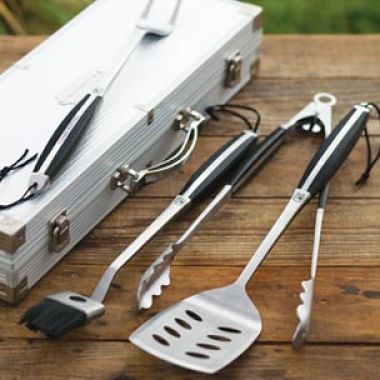
Williams-Sonoma offers a vast array of tools and gadgets designed to make grilling easier. A few are essential, some are useful, and others are just plain fun. The following accessories can make time spent cooking outdoors even more of a pleasure.
Grill Tools
Designed specifically for cleaning grills, a long-handled grill brush has rustproof metal bristles and a stainless-steel scraper. Use it while the grill is hot, before or after cooking, to scrape off any food particles stuck to the rack. Look for wooden handles; plastic handles can melt if left too close to the heat.
Extra-long tongs keep your hands at a safe distance from flame and sputtering meats. Use them for placing food on the grill, flipping and removing food for serving.
Long-handled brushes let you safely coat foods with marinades or sauces during cooking. Select brushes with long natural bristles securely attached to the handle.
A two-pronged fork is handy for spearing and moving large or awkwardly shaped foods. Choose tongs over a fork whenever possible, as spearing can mean the loss of flavorful juices.
Choose a sturdy spatula with an extra-long, well-insulated handle that ensures your hands and arms remain a safe distance from the heat.
Thermometers
An instant-read thermometer tells you in seconds whether meat or poultry is done. Insert the thermometer into food that is almost done to determine when it should come off the grill. Do not allow the thermometer to touch a bone, which will skew the reading, and never leave a thermometer in food while it is still on the grill. Some covered grills come with a built-in thermometer. If your grill does not, for long cooking over low heat, insert an instant-read thermometer in the vent opening to monitor the temperature inside the grill without opening the lid. A specialized grill thermometer or an oven thermometer can be attached to the grill rack to measure surface temperature.
Skewers
A good set of skewers makes grilling kabobs much easier. Flat-edged metal skewers can keep kabobs from rolling while they grill. Long skewers also can stabilize large pieces of meat, such as a butterflied leg of lamb, while it cooks. If you use wooden or bamboo skewers, submerge them in cold water and let them soak for at least 30 minutes prior to threading on food to prevent the skewers from burning.
Smoker Box
A small, vented metal smoker box holds aromatic wood chips or herbs inside a gas grill. The smoker box is placed directly over a heat element, filling the grill with flavorful smoke. The box prevents small particles from clogging the fuel ports of the grill. One drawback to using a smoker box is that the wood chips may fail to ignite if the grill heat is low. If this happens, or if you do not have a smoker box, you can fashion one out of aluminum foil: Place a large piece of heavy-duty foil on a work surface and mound a handful of wood chips or herbs in the center. Wrap the foil around the wood or herbs, folding it into a compact packet. Perforate the foil in several places with a fork or the tip of a knife to allow the smoke to escape during grilling.
Grill Baskets, Screens and Plates
Grill baskets are essentially two wire grids that can be latched shut to hold delicate foods, such as whole fish or fillets, securely. When grilling a dozen items, such as slices of bread for bruschetta, a grill screen lets you turn them all at one time with little effort. Grill baskets can also prevent small items, such as shrimp or sliced vegetables, from falling into the fire. Choose grill baskets with long, heatproof handles. To prevent sticking, brush or spray the inner surfaces of the basket with oil before using.
Like grill baskets, grill screens can prevent small items from slipping through the rack. Woven of fine wire mesh in a sturdy frame, screens are designed to rest directly on top of the grill rack. Brush or spray them with oil to keep foods from sticking, then let them heat for a minute or two before adding the food.
Perforated metal grill plates are another way to grill small items without worrying about losing them to the fire. Plates come in a variety of shapes and sizes and are evenly pierced with small holes. Coat with oil before using.
Chimney Starter
A metal cylinder with vents on the bottom and a handle on the side, a chimney starter is a safe, efficient and environmentally friendly tool for starting a fire in a charcoal grill. Choose a chimney that holds enough charcoal to fill your grill. A large chimney (about 7 1/2 inches in diameter and 12 inches tall) holds the right amount of charcoal to make a medium-hot fire in a medium or large kettle grill. Look for a chimney starter with a sturdy, wide handle.
Flame Source
Many gas grills come equipped with a spark igniter. If yours does not have one, use a long match or gas wand to light the flame.
Cast-Iron Fry Pans
A heavy cast-iron pan can rest on your grill rack for cooking shellfish, simmering sauces or heating gravies on the grill. Cast-iron is the best choice for grill-top cooking because it heats evenly, holds heat well and lasts a lifetime. You can use other types of fry pans if they can withstand the high heat from the grill and if you do not mind if the surface becomes blackened.
Protective Gear
An oven mitt and a pot holder made of heavy, quilted or coated cotton can help protect your hands from intense heat during grilling. A leather grill glove, with an extension that shields your forearm from the heat, provides the best protection. A full-length, heavy-duty apron guards against splatters on clothing.
Adapted from Williams-Sonoma, Essentials of Grilling, by Denis Kelly, Melanie Barnard, Barbara Grunes & Michael McLaughlin (Oxmoor House, 2003).











